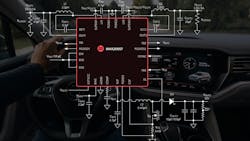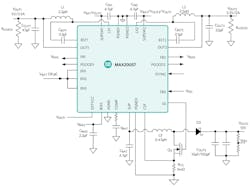Off-Battery PMIC Equipped to Take on Auto Electronics Blitz
Despite the improving fuel efficiency of modern automobiles, they continue to be burdened with ever-increasing electrical demands. These include the numerous in-cabin convenience, telematics connectivity, and infotainment features that provide information to the driver via the vehicle instrument cluster and/or head-up display (Fig. 1), which are controlled using touchscreens and switches located on the center console (commonly referred to as the radio head unit).
This article reviews the challenge of providing multiple supply rails to these systems using the vehicle battery as voltage input. Also touched upon are the challenges of meeting the required regulator output-voltage range while maintaining low quiescent current (IQ) and low EMI. Wrapping up the article is discussion of a new automotive power-management IC (PMIC) that removes the compromises associated with alternative solutions in meeting these challenges.
Automotive Power Requirements
To limit heat dissipation, automotive applications require highly efficient dc-dc converters that meet stringent manufacturer quiescent-current requirements. These converters must operate with a low input battery voltage to support cold-crank and start-stop events.
A common approach for managing cold crank is to use multiple PMICs (and other components) to step down the battery voltage with two stages of buck regulators. This requires complex circuit design and layout, which increases the solution size. Such an approach is also more susceptible to electromagnetic interference (EMI), making it difficult to meet EMI standards like CISPR class 5. Another concern arises in which loads are suddenly disconnected from the car battery (load-dump event) causing the rail voltage to suddenly spike. This could create potentially destructive transient voltages as high as 40 V.
Integrated PMIC
Instead of using a two-stage step-down with multiple regulators, a more straightforward approach is to use an integrated PMIC such as the MAX20057 (Fig. 2). The triple-output PMIC includes two synchronous buck converters (3.5 A and 2 A, and >90% efficiency) with an asynchronous boost controller that can be used to provide an adjustable voltage (10 V typical) to the buck converters. It also keeps them in regulation during cold-crank operation even if the battery voltage falls as low as the 2-V battery input.
Two high-voltage step-down converters operate 180 degrees out-of-phase to minimize input-current ripple from the minimum to the maximum input voltages The buck converters have a 3.5- to 36-V input operating voltage range with low operating current requirements of 10 µA (VOUT = 5V) and 8 µA (VOUT = 3.3V), ideal for voltage regulation when an automobile is switched off for extended periods of time. Such integration is well-suited for mid- to low-power cluster, head unit, and telematics applications because it enables a two-layer PCB design, helping lower overall solution cost.
EMI Mitigation
To address critical EMI concerns, the PMIC has a user-selectable spread-spectrum function that reduces peak EMI levels. This feature spreads spurious energy across a wider frequency band while also lowering its magnitude. Regulator switching frequency is fixed at either 400 kHz or 2.1 MHz.
High switching frequency provides multiple benefits, such as requiring smaller external components and reducing output-voltage ripple while also guaranteeing no AM band interference. The PMIC can be programmed to operate in any one of three modes for optimized performance as required, i.e., forced fixed-frequency operation, skip mode with ultra-low quiescent current, and phase-locked synchronization to an external clock, further aiding EMI mitigation.
Higher Voltage-Conversion Ratio
While some automotive PMICs include buck regulators that provide low output voltages from a relatively wide input range, they do so by running at a low switching frequency. That’s because the minimum voltage-conversion ratio (VOUT/VIN) is limited by the regulator’s minimum controllable “on-time” (typically 60 to 120 ns). For proper fixed-frequency pulse-width-modulation (PWM) operation and optimal efficiency, buck regulators must operate in continuous conduction mode (CCM) during normal operating conditions. In CCM, the minimum output-to-input voltage ratio is determined by the following formula:
This means that for a typical buck regulator with a minimum “on-time” of 120 ns and a 12-V input, maintaining CCM at 2.1 MHz means the output voltage can go no lower than 3 V (realistically, allowing for design margin, this could be up to 5 V in some circumstances). Achieving lower output voltages requires pulse skipping (decreasing the effective duty cycle), but this can increase unwanted EMI. To maintain a constant switching rate, the switching frequency must be reduced; however, this also negatively impacts EMI performance.
Unlike most other automotive regulators, the MAX20057 has a typical minimum “on-time” of 20 ns. Thus, its integrated buck regulators can theoretically achieve an output voltage down to 0.5 V (for 12-V battery input with 2.1-MHz switching frequency). This figure is below the minimum specified regulated output voltage (1 V), meaning it can be used to supply low-voltage rails without the need to reduce switching frequency. As a result, it’s able to maintain its EMI performance at low output voltage levels.
Another useful feature is the EXRVCC switchover that reduces power dissipation and improves light-load efficiency. Safety features include overcurrent and thermal overload protection, a UVLO that inhibits switching if the bias voltage drops below the falling threshold, and a soft-start to reduce input surge currents during startup.
Other variants of this PMIC include the MAX20457, which has dual 3.5/2.5-A buck converters (no boost controller) and the MAX20458, which has a single 3.5-A buck converter and boost controller. All versions are pin-compatible (meaning a single board design can be used in different applications) and are specified for the −40 to +125°C automotive operating temperature range.
Summary
This article reviewed the requirements for providing power to the infotainment, telematics, and head-unit systems located within the instrument cluster and center console of an automobile. We explained why some solutions trade off output-voltage range for EMI performance and showed how a highly efficient, low "on-time," automotive PMIC is designed to overcome this compromise. This suits it for use in all types of vehicles, including those using stop-start technology.
Starry Tsai is Executive Business Manager of Automotive Power, and Michael Jackson is Senior Technical Writer, at Maxim Integrated.



